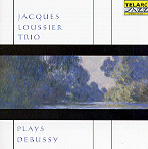Theoretically, this should work. There’s always jazz (more or less) lurking and roaming behind the scenes of Debussy’s musical stage-settings, and it’s often front and center, arising from particular scales, harmonies, and fluctuating, rubato-flavored rhythmic gridwork that either suggests or demands the kind of expressive freedom, technical discipline, and intellectual exploration that also are the essentials of jazz playing. Jacques Loussier is an old hand at this, exemplified in his still fascinating and musically satisfying jazzifications of Bach going back to the 1960s. This venture into Debussy is new, and it too is fascinating–at times absorbing and inspired (L’isle joyeuse), at others kind of well, uninteresting and uninspired (Clair de lune). If you like this sort of thing, if you “get” what’s going on–that is, you know the pieces in their original form and you have an appreciative affection (or deeper love) for jazz, then you definitely shouldn’t miss this ambitious and mostly successful program. It’s not all piano pieces–yes, there are the abovementioned works, plus La Cathédrale engloutie and Arabesque, but we also hear Prélude à l’après-midi d’un faune and Syrinx. Loussier and his two colleagues (Benoit Dunoyer de Segonzac on bass and André Arpino on drums) create some wonderful effects (percussion at the beginning of La Cathédrale and bass at the opening of the Prélude) and are careful to construct a different ambient world for each piece, through exploitation of Debussy’s already rich harmonies and by taking his ripe-for-jazz melodies and rhythms and working them into extended commentaries. You’ll have to decide whether Loussier’s decision to gospel-ize La Fille aux cheveux de lin was a good one, but he and his partners make Rêverie and Syrinx sound like jazz standards. The sound is fairly close, with prominent bass and realistic piano. [10/12/2000]
































